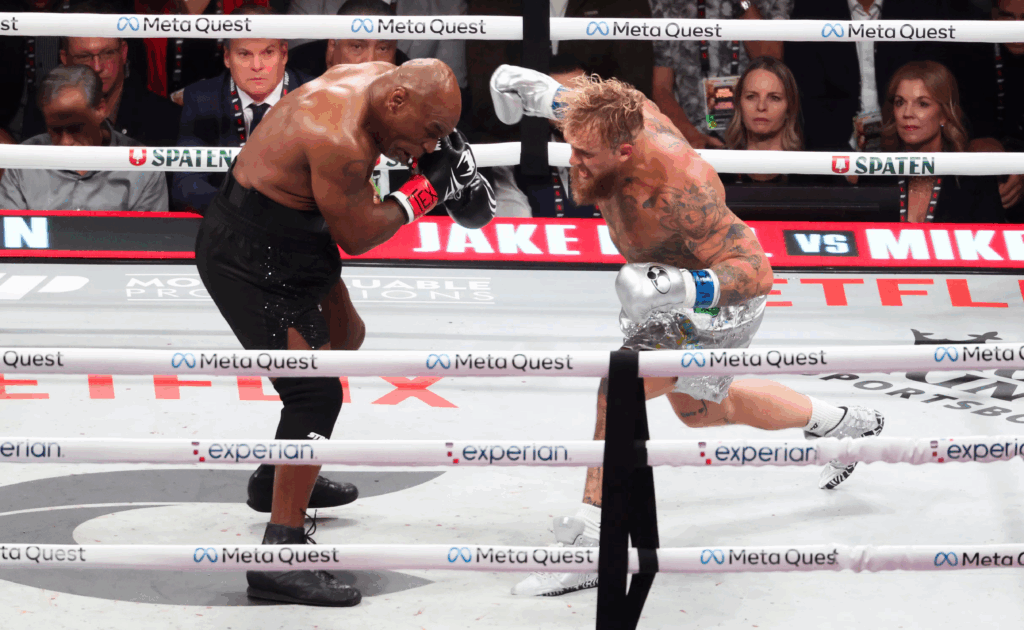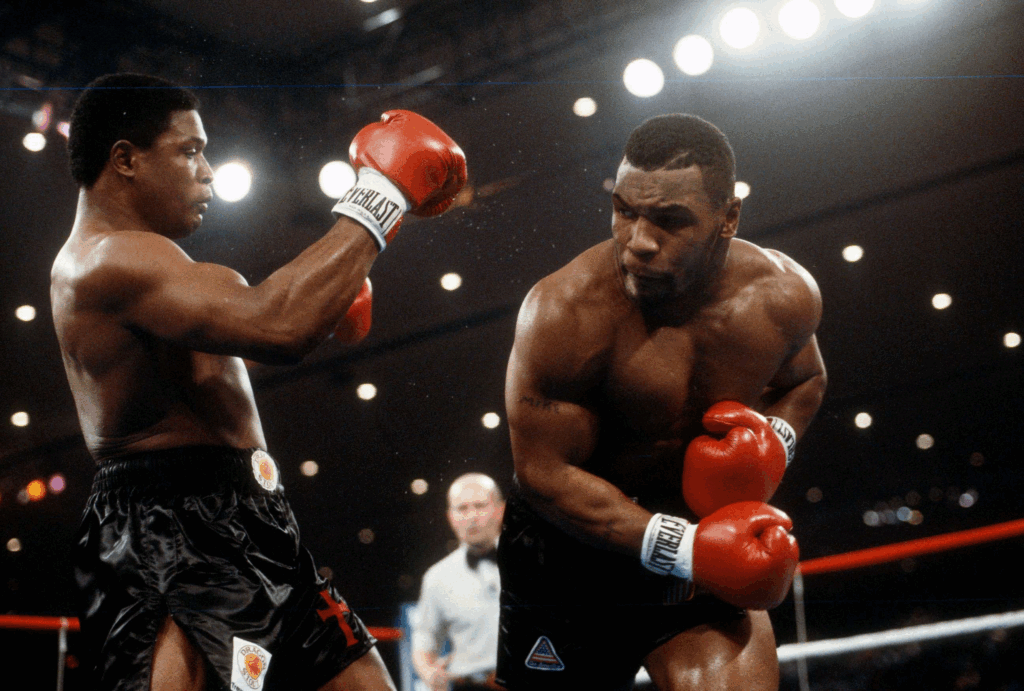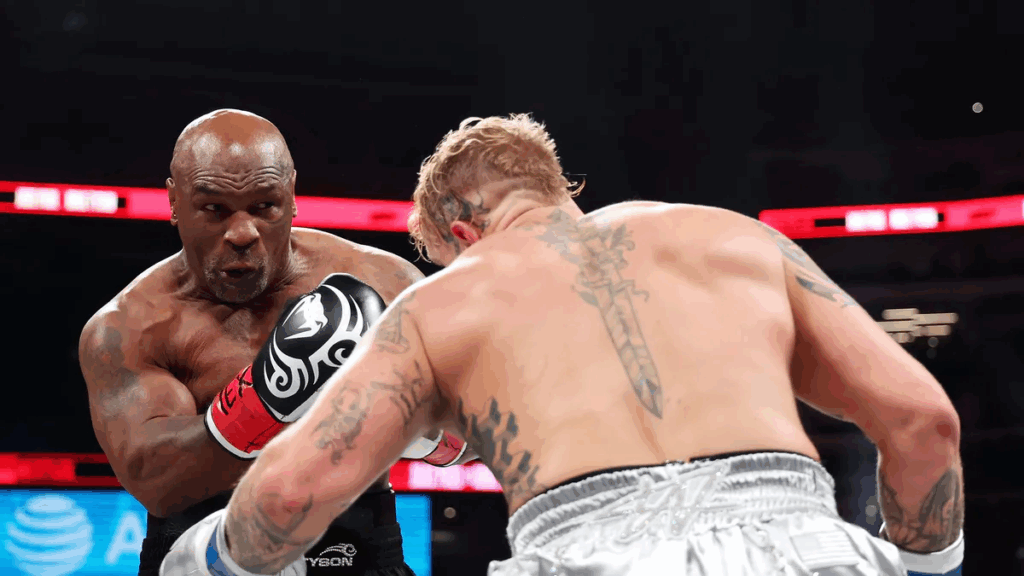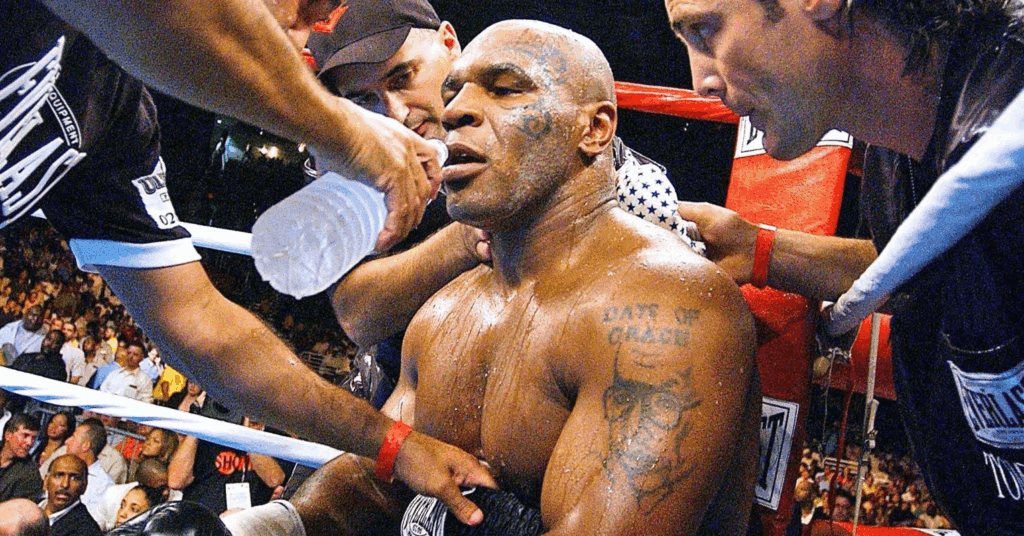
Aggressive Approach and Knockout Power
Mike Tyson was nothing if not a ferocious competitor from the start of his professional career. Unlike the majority of heavyweights that chose discretion and distance, Tyson didn’t get into the ring hoping to pace himself or make it a fight to be remembered, Tyson got in with only one goal in mind—get it over with and get it over with violently. That style of pressure, precision and terrifying punching domination remained his hallmark, and by the time he was done he was one of the most electrifying figures in the history of boxing.
Tyson’s Early Strategy in the Ring
Tyson’s early-ring strategy was not just about brute force—it was a carefully trained approach developed under Cus D’Amato’s philosophy. His tactics aimed to overwhelm and mentally break down his opponents before they could adjust.
Key elements of his early strategy included:
- Cutting off the ring: He used footwork to trap opponents, minimizing their movement and forcing them into exchanges.
- Fast starts: Tyson often came out explosively in the first round, setting a brutal pace and forcing his opponent onto the defensive.
- Close-range pressure: He closed the distance quickly, slipping under jabs to get inside and deliver damaging blows.
- Body attack: Tyson targeted the body to weaken opponents early, setting them up for head shots later in the fight.
- Combination punching: Instead of throwing single shots, he delivered rapid-fire combinations with surgical precision.
Unmatched Power and Speed
Tyson’s physical gifts were almost unmatched in his era. His rare combination of hand speed, explosive power, and compact build made him a unique force in the heavyweight division.
Highlights of his physical dominance:
- Devastating knockout power: Tyson won 44 of his 50 fights by knockout, many of them in the first round.
- Lightning-fast hands: His hand speed rivaled fighters in lighter divisions, allowing him to strike before opponents could react.
- Perfect technique: He delivered punches with impeccable form, maximizing power through leverage and timing.
- Relentless combinations: Tyson could throw 4–6 punch flurries in the blink of an eye, mixing uppercuts, hooks, and body shots.
- Left hook weapon: His signature left hook was often the beginning—or end—of a devastating sequence.
Together, Tyson’s aggressive mindset, strategic pressure, and physical advantages made him one of the most effective and feared heavyweights of all time.
The Peek-a-Boo Style of Boxing
This was the peek-a-boo style that helped drop jaws all around the word when it served as the style of fighting for Mike Tyson—a style made and taught by the late great Cus D’Amato. For all of Tyson’s renowned power and viciousness, it was this extremely sound and controlled defensive style that allowed him absorb his opponents’ artillery and then open up on them with his own heavy fire while he was protected nearly perfectly.
Understanding Tyson’s Unique Defensive Strategy
At the heart of the peek-a-boo style lies high and tight guard, with constant bobbing and weaving head and upper body movements. It’s not a traditional defensive posture where you stay in retreat, blocking shots, but it’s about slipping punches, staying with power and being able to counter punch back.

Tyson adopted and perfected this style:
- High guard: Tyson kept his gloves up near his cheeks, which protected his face while allowing quick strikes from either hand.
- Squared stance: Instead of standing sideways, he adopted a more squared-up position, giving him access to powerful punches from both the left and right.
- Offensive defense: Rather than backing up, Tyson would absorb or slip shots while moving forward—transforming defense into attack.
- Pressure and control: His defense wasn’t passive. By staying close and unpredictable, he forced opponents to make mistakes.
The peek-a-boo style allowed Tyson to move quickly into range while reducing the risk of taking clean punches. It was a style that emphasized control, rhythm, and explosive retaliation—ideal for a compact, power-heavy fighter like Tyson.
How He Used His Head Movement and Footwork
Tyson’s head movement was one of his most underrated weapons. While many associate defense with footwork alone, Tyson made his upper-body movement an art form, weaving in and out of danger with precision.

Key components of his defensive mobility included:
- Slipping and weaving: Tyson constantly moved his head from side to side, making it extremely difficult for opponents to land clean jabs or straight punches.
- Timing and rhythm: His head movement wasn’t random—it was timed to his opponents’ attacks, allowing him to slip punches and counter instantly.
- Pendulum motion: He often used a “bob and weave” motion, bending at the knees and rolling his upper body to create openings and confuse opponents.
- Explosive footwork: Despite his stocky build, Tyson had remarkably quick feet. He used short, powerful steps to cut angles and close the distance quickly.
- Pivoting inside: Once in range, Tyson would pivot around his opponent to find better angles for hooks and uppercuts, staying mobile while remaining in striking range.
Combined, Tyson’s footwork and head movement allowed him to stay aggressive while avoiding unnecessary damage. These elements made him not only a fearsome puncher but also one of the most defensively sound heavyweights during his prime—a complete fighter who mastered both offense and defense in equal measure.
Tactics and Mental Game
Sure, Mike Tyson was a genetic freak with a power that was perhaps otherworldly, but one of his most powerful weapons resided between his ears. Tyson didn’t merely fight with his fists — he frequently fought before there was even one round to fight. It was his mental approach to boxing – born of his childhood, his trainers, and his own psychology – that made it so he could beat you in the ring as much with his mind as with his body.
Tyson’s Intimidation Factor
Tyson’s very being alone was enough to rattle the vast majority of those who found themselves in the opposite corner. For when he first walked into the arena, in black trunks, no robe, no socks and that chilling gaze, he exuded pure menace. Lots of fighters physically wilted under that burden. The way he walked—mute, concentrated, almost animal-like—loomed with an aura of invulnerability.

He employed silence as a means of intimidation. Unlike so many boxers who would trash-talk in an attempt to win a psychological edge, Tyson didn’t need words. He let his actions, history and disposition speak for him. It wasn’t rare for opponents to actually lose their shit before the opening bell, because of the psychological baggage of facing someone with Tyson’s reputation.
The Psychological Battle in the Ring
Inside the ring, Tyson continued to apply pressure not just with punches, but with relentless forward movement and emotional dominance. He thrived on taking away an opponent’s confidence. Once a fighter showed hesitation or fear, Tyson would exploit it with ruthless efficiency.
Cus D’Amato taught Tyson that fear could be weaponized. Rather than deny it, Tyson learned to harness fear as fuel. He believed that controlling the mind was just as important as controlling the body. Every head movement, step forward, and stare-down was a calculated move to destabilize his opponent’s psyche.

If a fighter hesitated, flinched, or stepped back—Tyson would accelerate. His ability to sense weakness and turn it into opportunity was one of the most psychologically devastating tools in his arsenal. In many cases, by the time his first punch landed, the battle was already halfway over.
Tyson’s mastery of the mental game remains one of the least discussed but most crucial aspects of his greatness. He wasn’t just fighting bodies—he was dismantling wills.
Tyson’s Physical Attributes
Mike Tyson was physically different, and that came in play on everything on his boxing. Unlike other heavyweights of his time with height and reach advantage, Tyson was a short, muscular and compact fighter that catapulted fierce power from close distance. His body wasn’t just for show — it was a snarling, brawling biceps and V-shaped backside, perfectly sculpted for the fast, aggressive, defensive style he excelled at in the ring.
How Tyson’s Build Contributed to His Success
Standing at 5 feet 10 inches (178 cm), Tyson was significantly shorter than most heavyweights of his era. However, this lower stature worked to his advantage. His center of gravity gave him superior balance, allowing him to move in and out of range quickly and absorb punches more efficiently. His thick neck, broad shoulders, and powerful legs provided the torque and stability needed to deliver his trademark knockout blows.

Tyson’s physical build allowed him to:
- Stay low and slip punches effectively, making him a difficult target.
- Generate massive power from close quarters, especially in uppercuts and hooks.
- Explode with short, compact combinations, wasting no movement.
- Control the ring through tight angles and pivots, even against taller opponents.
His dense, muscular frame wasn’t for show—it was a finely tuned machine built for short-range destruction.
Comparing Tyson’s Physical Skills to Other Heavyweights
Unlike the towering heavyweights of his day, such as Lennox Lewis or Riddick Bowe, Tyson wasn’t using long jabs and rangy movement. Instead, he compensated for his relative lack of reach by being faster, quicker and better timed than everyone he faced. Whereas most big men exchanged largely in straight lines, Tyson fought in armed rocket curves, slipping inside, throwing searing, concussive fists, then rolling away in liquid motion.

Compared to his peers:
- Speed: Tyson’s hand speed was comparable to middleweights. Few heavyweights could match his ability to launch multi-punch combinations in under two seconds.
- Power: Pound for pound, Tyson was one of the hardest punchers ever. His knockouts weren’t just the result of force—they came from perfectly timed, well-placed shots.
- Footwork: Unlike many heavyweights who moved heavily and slowly, Tyson’s footwork was sharp and purposeful, helping him cut off the ring and close distance rapidly.
While taller fighters often had the advantage on paper, Tyson’s physical gifts—combined with his technique and mental toughness—made him a nightmare matchup. He redefined what a “dangerous” heavyweight could look like and proved that speed, precision, and compact power could outperform height and reach when used effectively.